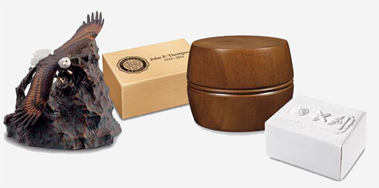Cremation History
(condensed from Wikipedia)
Cremation dates from at least 20,000 years ago in the archaeological record, with the Mungo Lady, the remains of a partly cremated body found at Lake Mungo, Australia. Alternative death rituals emphasizing one method of disposal of a body—inhumation (burial), cremation, or exposure—have gone through periods of preference throughout history.
Cremation remained common, but not universal, in both ancient Greece and ancient Rome . According to Cicero , in Rome, inhumation was considered the more archaic rite, while the most honoured citizens were most typically cremated—especially upper classes and members of imperial families.
The rise of Christianity saw an end to cremation, being influenced by its roots in Judaism, the belief in the resurrection of the body, and following the example of Christ's burial. Anthropologists have been able to track the advance of Christianity throughout Europe with the appearance of cemeteries. By the 5th century, with the spread of Christianity, the practice of burning bodies gradually disappeared from Europe.
In early Roman Britain , cremation was usual but diminished by the 4th century. It then reappeared in the 5th and 6th centuries during the migration era, when sacrificed animals were sometimes included with the human bodies on the pyre, and the deceased were dressed in costume and with ornaments for the burning. That custom was also very widespread among the Germanic peoples of the northern continental lands from which the Anglo-Saxon migrants are supposed to have been derived, during the same period. These ashes were usually thereafter deposited in a vessel of clay or bronze in an "urn cemetery". The custom again died out with the Christian conversion of the Anglo-Saxons or Early English during the 7th century, when Christian burial became general.
Middle Ages Cremation
Throughout parts of Europe, cremation was forbidden by law, and even punishable by death if combined with Heathen rites. Cremation was sometimes used by Catholic authorities as part of punishment for Protestant heretics, and this did not only include burning at the stake. For example, the body of John Wycliff was exhumed years after his death and burned to ashes, with the ashes thrown in a river, explicitly as a posthumous punishment for his denial of the Roman Catholic doctrine of transubstantiation .
Modern Era Cremation
The first to advocate for the use of cremation was the physician Sir Thomas Browne in 1658. Honoretta Brooks Pratt became the first recorded cremated European individual in modern times when she died on 26 September 1769 and was illegally cremated at the burial ground on Hanover Square in London .
The organized movement to reinstate cremation as a viable method for body disposal began in the 1870s. In 1869 the idea was presented to the Medical International Congress of Florence by Professors Coletti and Castiglioni "in the name of public health and civilization". In 1873, Professor Paolo Gorini of Lodi and Professor Ludovico Brunetti of Padua published reports or practical work they had conducted. A model of Brunetti's cremating apparatus, together with the resulting ashes, was exhibited at the Vienna Exposition in 1873 and attracted great attention, including that of Sir Henry Thompson, 1st Baronet , a surgeon and Physician to the Queen Victoria , who returned home to become the first and chief promoter of cremation in England.
Sir Henry Thompson's main reason for supporting cremation was that "it was becoming a necessary sanitary precaution against the propagation of disease among a population daily growing larger in relation to the area it occupied". In addition, he believed, cremation would prevent premature burial, reduce the expense of funerals, spare mourners the necessity of standing exposed to the weather during interment, and urns would be safe from vandalism. On 13 January 1874, some advocates of cremation, including Anthony Trollope , John Everett Millais , George du Maurier , Thomas Spencer Wells , John Tenniel and Shirley Brooks , held a meeting at Thompson's house in London and formally founded the Cremation Society of Great Britain "...expressly for the purpose of obtaining and disseminating information on the subject and for adopting the best method of performing the process, as soon as this could be determined, provided that the act was not contrary to Law."
The first duty of the Cremation Society was to ascertain whether cremation could be legally performed in the country, and then to construct a first crematorium. In 1878, Sir Henry Thompson bought a piece of land in Woking as a site for the crematorium. Professor Gorini was invited to visit Woking and supervise the erection of his cremation apparatus there . They first tested it on 17 March 1879 by cremating the body of a horse. However, the inhabitants of Woking showed strong antipathy to the crematorium, and appealed to the Home Secretary , Sir Richard Cross , to prohibit the use of the building.
Legalization of cremation came about through the eccentric activities of Welsh Neo-Druidic priest, William Price . After his first child died in 1884, and believing that it was wrong to bury a corpse, thereby polluting the earth, Price decided to cremate his son's body. He was arrested by the police for the illegal disposal of a corpse. Price successfully argued in court that while the law did not state that cremation was legal, it also did not state that it was illegal. The case set a precedent that, together with the activities of the newly founded Cremation Society of Great Britain, led to the Cremation Act 1902 . The Act imposed procedural requirements before a cremation could occur and restricted the practice to authorised places.
In 1885, the first official cremation in the UK took place in Woking. The deceased was Mrs Jeannette C. Pickersgill , a well-known figure in literary and scientific circles. By the end of the year, the Cremation Society of Great Britain had overseen two more cremations, a total of 3 out of 597,357 deaths in the UK that year. In 1886 ten bodies were cremated at Woking Crematorium . During 1888, in which 28 cremations took place, the Cremation Society planned to provide a chapel, waiting rooms and other amenities there. In 1892 a crematorium opened in Manchester , followed by one in Glasgow in 1895, Liverpool in 1896 and Birmingham Crematorium in 1903.
Crematoria in Europe were built in 1878 in the town of Gotha in Germany and later in Heidelberg in 1891. The first modern crematory in the U.S. was built in 1876 by Francis Julius LeMoyne after hearing about its use in Europe. During that time it was thought that people were getting sick by attending funerals of those recently deceased and that decomposing bodies were leaking into the water systems. LeMoyne built the crematory to cremate bodies in a controlled environment primarily for sanitary reasons. Cremation was used to destroy any organic matter that could cause illness and give families a better way to preserve ashes. Before LeMoyne's crematory closed in 1901, it had performed 42 cremations.
In the U.S. only about one crematory per year was built in the late 19th century. As embalming became more widely accepted and used, crematories lost their sanitary edge. Not to be left behind, crematories had an idea of making cremation beautiful. They started building crematories with stained-glass windows and marble floors with frescoed walls. By 2008, the cremation rate was 36.2% and was growing about 1 percentage point a year, according to CANA. CANA is the largest organization representing crematories and funeral homes in the U.S. and Canada
Cremation Cost:
$2871.45 CDN*
Taxes Included
Additional charges: After-hours transfer fee 5:00 pm – 8:30 am, Mileage fee outside our 30-km mileage radius.
*All payments processed with credit cards are subject to a 2.4% processing fee.
Our cremation process is very simple. Contact us to obtain login credentials, and then complete our form to record your loved one's Vital Statistics.

We have a beautiful array of cremation and keepsake items.



